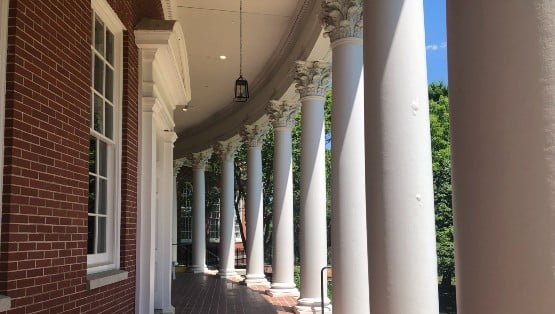
The fact that there is no direct pedestrian connection between the Potomac River waterfront and Rosslyn has puzzled Kris Krider since joining Arlington County as planning supervisor for urban design and research in 2013.
When Steven Cover was named director of the county’s Department of Community Planning, Housing, and Development, he had the same reaction.
“Most cities and counties have recognized the value of their waterfronts as a gathering place but the waterfront below Rosslyn has little pedestrian access and must overcome the barrier of busy highways and large numbers of drivers using the graceful George Washington Memorial Parkway as a commuter route who just whiz by with seemingly no interest in stopping to explore the area,” Krider said.
To generate some creative ideas that could make the waterfront more inviting, Arlington County turned to students at the Virginia Tech Washington-Alexandria Architecture Center.
“We felt they were in a unique position to help us because they could be both imaginative and unconstrained, unworried about ruffling any feathers among the many landowners and agencies in the area,” he said.
Paul Kelsch, associate professor in the Landscape Architecture program, was sure that the mix of graduate and undergraduate students in his spring design studio were up to this challenge.
“I really liked the idea that Arlington County’s urban design team was looking to our students not strictly for a new park at the waterfront, but for really imaginative and transformative ideas,” said Kelsch.
Kelsch and instructor and Ph.D. student Jodi LaCoe developed three programs the students could choose from as they began to imagine their designs:
- Bike, Bathe, and Beyond — a connection to existing bike paths leading people to the site in addition to some form of bathing. This could include things like a structure for storing one’s bike; showering and heading to work; a new spa along the bike path; or swimming in a cleaner Potomac River or a public pool.
- A Food-Boat Wharf — a place where future food boats could moor along the river’s edge and sell to Rosslyn workers looking for a delectable waterside lunch.
- Urban Drive-In Theater — entertainment for people coming by foot, bike, or car to watch movies or other performances.
The following are a few examples of the designs that Virginia Tech students presented to Arlington County:
- New Causeway. Graduate student Ian Hunter, of Alexandria, Virginia, transformed the waterfront by proposing a new causeway for the parkway that enclosed a lagoon and allowed for more intimate contact with the water. A small stream runs down a narrow ravine and then flows into the lagoon, where a protected beach would allow children to wade in the water and kayakers could launch boats to explore the river. The causeway itself extends across shallow water, rising onto piers where the water is deeper, and aligns through the center of the second arch of the existing Key Bridge. The site of the existing roadway would be regraded for a variety of park uses along the new, protected waterfront. Berms along the new roadway would screen the noise of the cars so they would not be intrusive.
- Natural Swimming Pool. Graduate student Paige Courtney, of Alexandria, Virginia, proposed relocating the parkway inland, cutting it into the slope with a large retaining wall so she could use the former roadbed for innovative storm water management and a natural swimming pool along the waterfront. She channeled a small tributary flowing down the hillside into a filtering wetland along the former westbound lane of the parkway. After calculating the amount of storm water collected in regular storms, she sized wetlands to filter it sufficiently for swimming in two successive pools, one for swimming laps and one for family swimming. A small waterfall plunges from the upper pool into the lower one where children can play as it cascades into the shallower basin. The former eastbound lane of the parkway provides vehicular access and parking for the new facility.
- Showering Under The Parkway. Undergraduate student Will Scott, of Lewisburg, West Virginia, relocated the parkway slightly inland where it would sit higher up the slope and constructed a bathing facility for bicycle commuters underneath the parkway. Cyclists would be able to ride along the river on the Mount Vernon Trail, park their bikes, shower, and make their way through an ascending set of courtyards and new buildings to reach the commercial heart of Rosslyn. The large piers of the elevated parkway would give the showers and locker facilities an industrial scale in notable contrast to the human scale of the bathers. A set of four conical stair towers allows pedestrians to cross over other roadways and then descend to ground level, making a sequence of above ground, at-grade, and below ground spaces connecting the commercial district to the river.
In May, the students presented 18 designs to Arlington County staff, residents, agencies, and property owners. In June, their work was put on display at the county administration building for public viewing.
The students’ designs are featured on this Arlington County webpage, which highlights the Virginia Tech-Rosslyn Waterfront project.
“We are very grateful for the opportunity to work with Virginia Tech students,” Krider said. “Limited only by site constraints and their imagination, they had the freedom to create a wide variety of great concepts incorporating emerging best practices and context-sensitive design techniques. They are all worth considering more closely as Arlington works toward a solution for envisioning the Rosslyn waterfront as a regional recreational destination.”










